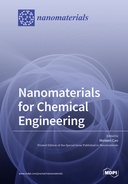Explore

Nanomaterials for Chemical Engineering
Meiwen Cao (editor)
2023
0 Ungluers have
Faved this Work
Login to Fave
Scientists and engineers have emphasized the study of nanomaterials in recent decades. By having superior properties, nanomaterials are helping to greatly improve and even revolutionize the development of various technology and industry sectors. Despite many advantages, there are challenges present in the control and design of nanomaterials with specific properties (e.g., morphology, size, porosity, conductivity, optical property, photoelectric property, chemical activity, etc.) to meet with their functional aims. The main applications of nanomaterials in the chemical engineering area are catalyst, coating, adsorption, sensor, drug delivery, etc., which all have fascinating yet challenging research topics.This reprint collects original research papers and comprehensive review papers that cover the topics of development of novel nanomaterials and synthesis methods, experimental characterization and computational modelling studies, as well as exploitation in devices and practical applications, hoping to bring new insights into the chemical engineering area.
This book is included in DOAB.
Why read this book? Have your say.
You must be logged in to comment.
Rights Information
Are you the author or publisher of this work? If so, you can claim it as yours by registering as an Unglue.it rights holder.Downloads
This work has been downloaded 68 times via unglue.it ebook links.
- 68 - pdf (CC BY) at Unglue.it.
Keywords
- (3-Glycidyloxypropyl)trimethoxy silane
- 2D R-P type perovskite
- Ag@V2C MXene
- alkylamines
- capping agent
- CeO2
- CH4 adsorption
- Conotrachelus humeropictus
- controlled release
- controlling agent
- Coriolis force
- crystal-plane
- cyclic adsorption
- Disturbances
- Drude-Smith model
- ethane
- extended line defect
- finite element analysis
- first principles
- flow spike
- flow strategy
- fluidization
- fractal analysis
- frequency
- functional cotton fabrics
- gene delivery
- Gene Therapy
- glycerol carbonate
- Graphene
- grid independence analysis
- H2 permselectivity
- heat of adsorption
- hybrids
- hydrogenation
- hydrophobicity
- hydrothermal process
- hydrothermal stability
- ideal adsorbed solution theory
- Lippia origanoides
- maleic anhydride
- Maxwell nanofluid
- Methane
- Mg-Zr oxides
- microporous membrane
- mixture adsorption
- Mn modification
- molecular dynamic
- Moniliophtora perniciosa
- Morphology
- n/a
- nanocomposites
- nanoflakes
- nanoflowers
- nanohybrid coatings
- Nanoparticles
- nanoporous carbon
- nanoscale surface
- natural gas storage
- Ni loading
- Ni/CeO2
- nonlinear optical properties
- nonviral vector
- numerical molecular simulation
- OPTP
- oxygen vacancies
- particle size
- PECVD
- peptide
- photocatalysis
- pulsation
- Regeneration
- self-assembly
- SnS2 nanoparticles
- sol–gel
- Structure
- suction/injection
- Technology, engineering, agriculture
- Technology: general issues
- terahertz modulation
- Theobroma grandiflorum
- thermal decomposition
- transesterification
- ultrafast characteristics
- wastewater treatment
- Z-scan
- zeolite
- Zinc oxide
- zirconia-doped SiO2 membrane
Links
DOI: 10.3390/books978-3-0365-7536-0Editions

